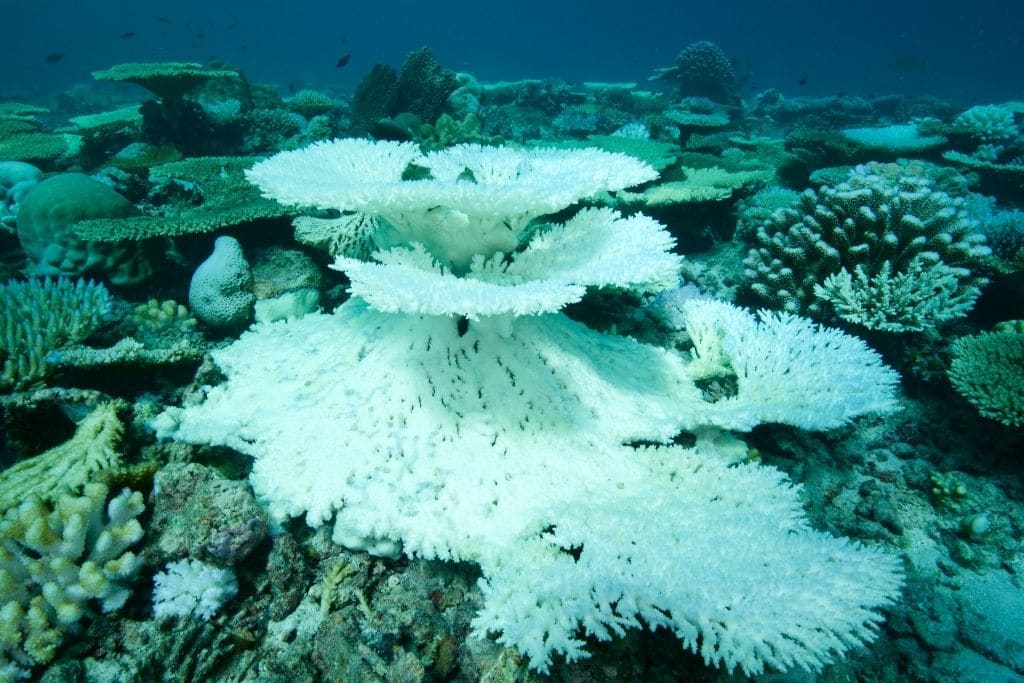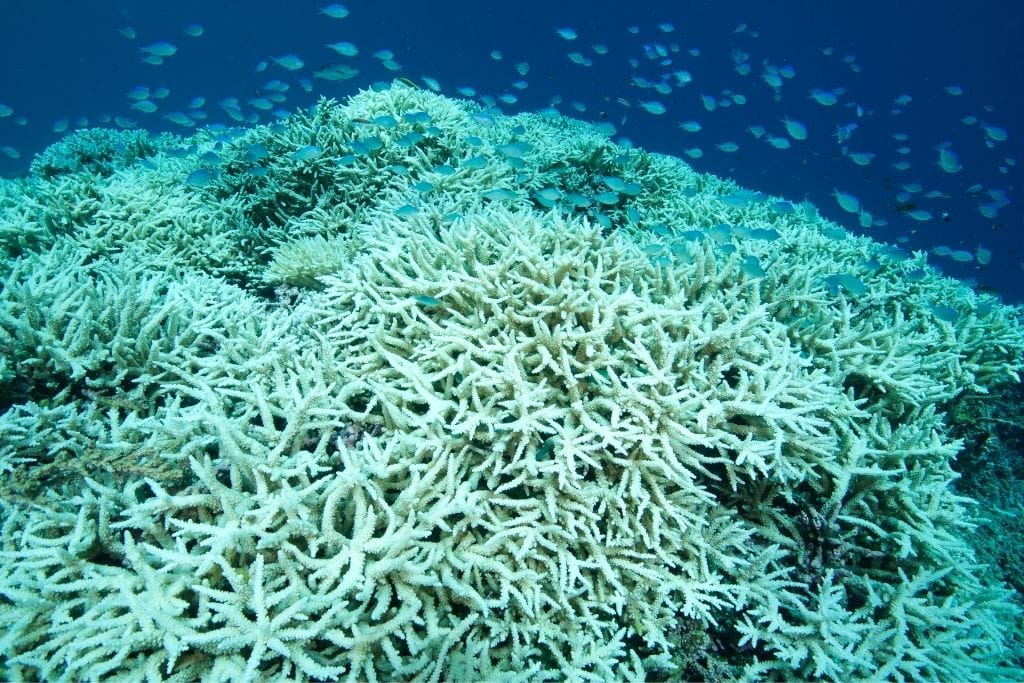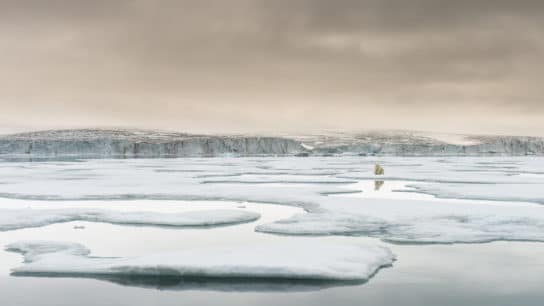Coral reefs are the world’s most diverse marine ecosystems. Despite covering only 2% of the ocean area across more than 100 countries, coral reef systems are home to 25% of all marine species. Aside from their rich biodiversity, coral reefs are vital in protecting coasts from erosion and slow storm surges. They are economically significant, too, generating US$2.7 trillion per year in revenue across the food, tourism, and pharmaceutical industries around the world. Yet the health and survival of our precious coral reefs are teetering as global temperature rises and oceans become more acidic, causing widespread coral bleaching across the world’s oceans. We take a look at what coral bleaching is as well as its causes and effects.
—
What Is Coral Bleaching?
Coral bleaching is a phenomenon in which coral reefs expel the microscopic marine algae called zooxanthellae that live in their tissues when under stress – be it heat, ocean acidification, or human activity. As a result, coral tissues become transparent and lose their signature vibrant colours, exposing their white exoskeleton underneath.
While coral bleaching does not mean that the corals have died, it increases their vulnerability to marine disease and starvation, which could eventually lead to mortality. The longer corals are bleached under various stresses, the more difficult it will be for algae to return, making it impossible for reefs to be revived.
Coral bleaching is a natural process that takes place during summers when ocean temperatures are warmer. However, recent large-scale marine heatwaves have led to more frequent and severe mass coral bleaching events around the world, with reefs’ natural recovery processes struggling to keep up.
One of the best examples of coral bleaching is the Great Barrier Reef, the world’s largest and longest reef system located off the coast of Queensland, Australia, which covers about 350,000 square kilometres – an area that is larger than the UK and Ireland combined. The stunning coral reef system has already suffered five mass bleaching events in 1998, 2002, 2016, 2017 and 2020. The events in 2016 and 2017 were so severe that it led to the death of 50% of the iconic reef.
According to the most recent report by the Global Coral Reef Monitoring Network (GCRMN), analysis showed that the world has lost approximately 14% of corals since 2009. Aside from Australia, coral death has been particularly pronounced in regions such as South Asia, the Pacific, East Asia, the Western Indian Ocean, The Gulf, and Gulf of Oman.

You might also like: What Are Coral Reefs and Why Are They So Important?
Causes of Coral Bleaching
As mentioned, coral bleaching can be a natural process that occurs due to rising oceans temperatures, particularly during summer seasons and natural phenomena such as El Niño, a quasi-periodic fluctuation in oceanographic and atmospheric conditions that brings in warm water. But worsening mass bleaching events have been brought on and exacerbated by human activities and influence.
Human-induced climate change has led global ocean temperatures to persistently rise. Within the last century, sea temperatures rose at an average rate of 0.13C every decade. Warmer waters make coral reefs more vulnerable to bleaching outside of summer seasons while impeding their ability to naturally recover.
Warmer waters and soaring carbon dioxide in the atmosphere also lead to ocean acidification – oceans act as carbon sinks to absorb and store CO2, changing the chemical balance. Today, coral reefs are experiencing more acidity than they have at any time in the last 400,000 years, which reduces the water’s carrying capacity for calcium carbonate for coral reefs to rebuild their exoskeletons.
Changes in sun exposure and coastal development are contributing factors as well. Soaring plastic pollution in particular has been a plague to oceans and marine ecosystems in recent years, where animals mistakenly ingest plastic debris as food and get entangled in abandoned fishing gears. Plastics and smaller plastic particles called microplastics are also impacting water quality, and can suffocate and restrict sunlight access for the reefs.
Overfishing and our overall damaging practices in ocean-floor ecosystems for coastal development such as dredging, quarrying, and bottom trawling, not to mention sediment pile ups from agriculture, all have a hand in delivering devastating damages and bleaching to coral reefs, too.
Coral bleaching, however, does not occur equally due to the aforementioned conditions. They are most common in regions experiencing more frequent and extreme heat waves, while areas with more stable temperatures and less heat stress see fewer corals bleached. To use the Great Barrier Reef as an example again, it faces much higher risk of bleaching every summer and mass bleaching events are attributed to the fact that Australia has warmed by 1.4C since the Industrial Revolution, a rate that is faster than the global average.
You might also like: 5 Coral Reefs That Are Currently Under Threat and Dying

The Effects of Coral Bleaching
Coral reefs play a significant role in ocean habitats and the ecosystem for marine life, but based on current temperature rise and ocean acidification trends, scientists have estimated that they could be completely wiped by 2050.
The State of the Coral Reef 2020 report found that the world lost 14% of its coral reefs between 2009-2018 due to rapid increases in sea surface temperatures, which amounts to about 4,500 square miles or more than the size of all the living corals in Australia. Each mass bleaching event makes it harder for coral reefs to recover and replenish its cover. The 1998 mass bleaching event saw global hard coral cover drop by 32.5%. By 2009, corals managed to recover to a very healthy level. But with each mass bleaching event, coral growth has struggled to match the rate of bleaching and death.
As coral reefs support 25% of all marine species in the world, a reduced biodiversity of coral reefs could see the elimination of key species. There will be less habitat for the hundreds of thousands of species, threatening their survival and population numbers, throwing entire ecosystems and food webs off balance.
Worsening climate change brings with it more severe and frequent storms and extreme weather events, producing excessive nutrient or sediment runoff. Without the protection of coral reefs, coastal communities face a higher risk of storm surges as well.
What’s more, considering the staggering amount of revenue coral reefs generate across different industries including tourism, the loss of coral reefs could cost billions of dollars along with jobs and livelihoods across the world.
The Future of Coral Reefs
As the Great Barrier Reef faces its sixth mass bleaching event, we urgently need stronger policies and solutions to protect our highly vulnerable coral reefs. We need to give up our dependence on fossil fuels to slow down global warming, which reduces ocean acidification and temperature rise. We need to overhaul our fishing and coastal development practices, on top of tackling ocean plastic pollution, to improve water quality and minimise runoff. Finally, we need far more investment in reef management and conservation, coupled with funding for research into reef resilience.
However, it’s not all bleak. According to the aforementioned report, most coral reefs are hardy enough to recover on their own if the environmental conditions prevail. Global cover for instance has rebounded to pre-1998 levels within a decade. Some recovery was also observed in 2019 with coral reefs regaining 2% of their cover.
You might also like: Coral Reef Breakthrough Launches to Prevent Extinction of One of the World’s Most Threatened Ecosystems
Some coral reefs have also been found to be more resilient than others. The corals in the Gulf of at the northernmost tip of the Red Sea have shown signs to have developed higher thresholds in withstanding warmer temperatures than most corals. A new coral reef in the waters of the southern Pacific Ocean off the coast of Tahiti was also recently been discovered to have been untouched by coral bleaching, offering new hope that many more unknown, and possibly pristine, coral reefs remain in the ocean.
This story is funded by readers like you
Our non-profit newsroom provides climate coverage free of charge and advertising. Your one-off or monthly donations play a crucial role in supporting our operations, expanding our reach, and maintaining our editorial independence.
About EO | Mission Statement | Impact & Reach | Write for us


















